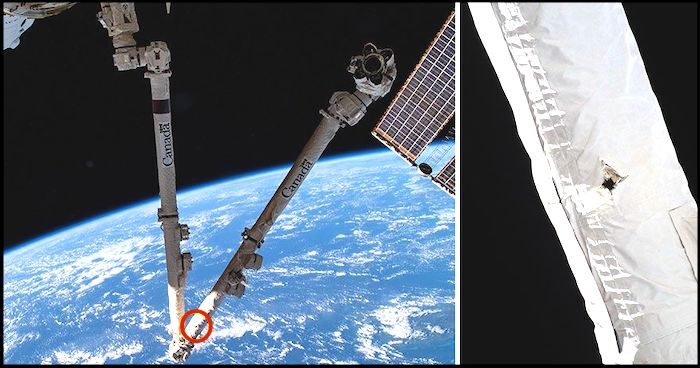In a blog post, the CSA notes that 'a small section of the arm boom and thermal blanket' of Canadarm2 was hit. The space agency first noticed the incident 'during a routine inspection' on May 12. 'Despite the impact, results of the ongoing analysis indicate that the arm's performance remains unaffected,' CSA wrote in the post, adding that the robotic arm is 'continuing to conduct its planned operations.'
The amount of space junk has increased since the dawn of the space age and now and then, they have caused damage. NASA explained that 'a number' of space shuttle windows were replaced due to damage from material that was later found out to be paint flecks.
According to the US space agency, more than 27,000 pieces of space junk are tracked.
NASA wrote in the post:
'Since both the debris and spacecraft are traveling at extremely high speeds (approximately 15,700mph in low Earth orbit), an impact of even a tiny piece of orbital debris with a spacecraft could create big problems,'Of the 27,000, 23,000 are larger than a softball and are traveling at speeds up to 17,5000mph.
Approximately 500,000 more are larger than a marble (0.4inches) and approximately 100 million pieces are .04 inches (or one millimeter) and larger.
Even more are smaller than a micrometer, at just 0.000039 inches in diameter.
In a recent report, the European Space Agency noted much of these fragments are leftover fuel or exploding batteries. There has been an average of 12.5 'non-deliberate fragmentations' occurring every year for the past two decades.
Earlier this year, an expert warned that all of the debris left by humans in low-Earth orbit have become the equivalent of a 'new drifting island of plastic' in outer space. There are an estimated 170 million pieces of so-called 'space junk' - left behind after missions that can be as big as spent rocket stages or as small as paint flakes - in orbit alongside some US$700 billion (£555bn) of space infrastructure.
But only 22,000 are tracked, and with the fragments able to travel at speeds above 16,777 mph (27,000kmh), even tiny pieces could seriously damage or destroy satellites.
However, traditional gripping methods don't work in space, as suction cups do not function in a vacuum and temperatures are too cold for substances like tape and glue. Grippers based around magnets are useless because most of the debris in orbit around Earth is not magnetic.
Most proposed solutions, including debris harpoons, either require or cause forceful interaction with the debris, which could push those objects in unintended, unpredictable directions.
Scientists point to two events that have badly worsened the problem of space junk. The first was in February 2009, when an Iridium telecoms satellite and Kosmos-2251, a Russian military satellite, accidentally collided. The second was in January 2007, when China tested an anti-satellite weapon on an old Fengyun weather satellite.
Experts also pointed to two sites that have become worryingly cluttered. One is low Earth orbit which is used by satnav satellites, the ISS, China's manned missions and the Hubble telescope, among others. The other is in geostationary orbit, and is used by communications, weather and surveillance satellites that must maintain a fixed position relative to Earth.




Comment: More details were offered from another report: